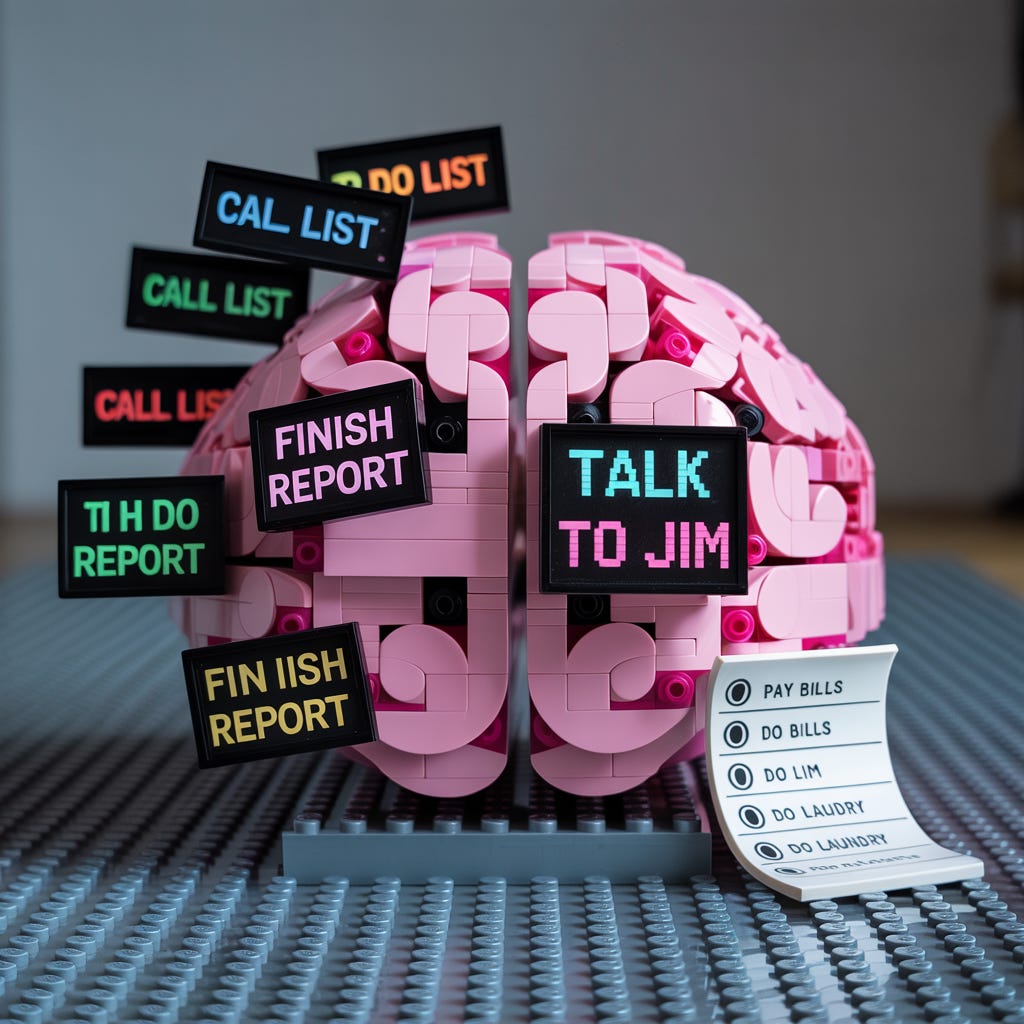Your Brain Wasn’t Built for Task Management
Build a simple capture habit to offload your brain, reduce stress, and stay on top of everything that matters.
Your brain has 86 billion neurons and up to a quadrillion synapses firing away, passing information at speeds of up to 350 miles per hour. As far as science is concerned, your brain’s storage capacity is virtually unlimited.
And yet… You probably forgot something the last time you went to the grocery store.
“Your mind is for having ideas, not holding them.” – David Allen
Even though your brain is powerful, it’s terrible at reminding you of the right thing at the right time. Instead, it loves to interrupt you with random, stressful thoughts when you can’t do anything about them.
Think of it like this: You’re working on your laptop, and every few minutes a pop-up window appears reminding you of some unrelated task, "Finish the report," "Buy milk," "Call Mom," "Pay tuition." That’s exactly what your brain does to you all day long.
This is more than annoying; it’s mentally exhausting.
The Solution: Offload Your Brain
The way out is surprisingly simple: write things down.
This practice, known as distributed cognition, relieves your brain from the impossible task of remembering everything all the time. You offload the mental burden to tools and systems you trust, freeing your mind to focus on what matters.
You’ve likely felt this before:
You’re overwhelmed, so you make a to-do list. Suddenly, you feel more in control.
You’re packing for a trip, so you make a checklist. You immediately feel less stressed.
You jot down an idea, and your brain stops obsessively looping it in the background.
So why do we wait until we're near burnout before we do this?
Build a Capture Habit — Before You Burn Out
The real power of writing things down isn’t just preventing forgetfulness. It’s about freeing your mind, focusing your attention, and showing up better in every part of life.
Here’s what happens when you build a strong capture habit:
You free up mental bandwidth
Your brain can only juggle 7 (plus or minus 2) ideas at a time. Writing a thought down gives your brain permission to let it go and opens up space for clearer thinking.
You become more present
Instead of obsessively turning over a to-do item in your head, you capture it and move on. That frees you to focus on the meeting, the project, the conversation with your partner or kids, whatever is in front of you.
You reduce anxiety
Your brain usually reminds you of things when you can’t act on them. That’s a huge source of stress. Capturing tasks removes the pressure to remember them constantly.
You build trust
When you consistently write things down, you stop dropping balls. You follow through. That builds trust with coworkers, professors, clients, friends, and family.
How to Start Capturing Everything
You don’t need a fancy system to start, just a commitment to stop trying to remember everything.
Here’s a simple 3-part framework:
1. Make Capture Frictionless
Ideas come fast. You need to be able to jot them down in seconds.
Pick one digital method and one physical method—and stick to them.
Personally, I email notes to myself and keep a stack of 3×5 index cards on my desk.
2. Review Your Inboxes
Capturing is only half the battle. If you don’t review your inboxes, your brain won’t trust them.
Set a recurring time—once a week is enough—to clear your mental inbox and take action on what you’ve captured.
3. Use a Trusted To-Do List
Some captured thoughts will require action later. Get them onto a trusted to-do list—one you review regularly enough to know nothing will slip through the cracks.
I use a digital tool called Todoist, but paper works fine too. The key is trust: your brain must know the list works.
This Week’s Challenge
Here’s your action step:
Choose a digital or physical capture method today.
Commit to writing down any thought you have more than once.
At the end of the week, review what you’ve captured. Move anything actionable to your to-do list.
Your brain is a miracle of biology, but it’s not a project management system. Don’t force it to be one.


